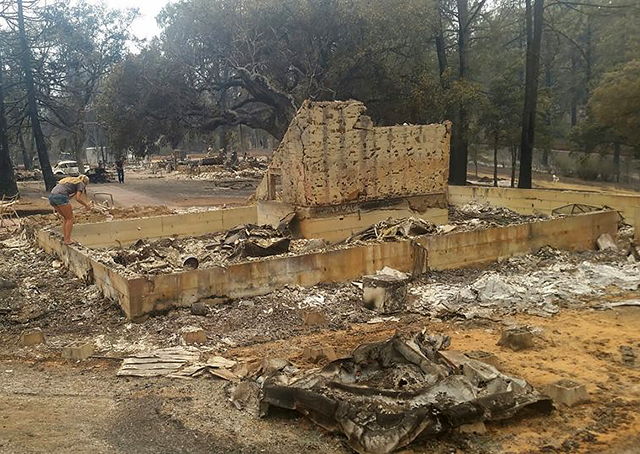
Axel Alvarez saw plumes of orange flames piercing thick, black smoke from California’s Butte fire below his left wingtip. “It was crazy, seeing the intensity of the fires,” the aerospace designer said. “The red and orange glow behind the smoke is something I’ve never seen before.” Alvarez was flying a Mooney through the Sierra Nevada valley south of Sacramento to pick up a new propeller for his modified Van’s Aircraft RV-4 on Sept. 11 as firefighters battled the huge blaze.
His destination was Catto Propellers at Westover Field Amador County Airport in Jackson, California, where owner Craig Catto and his family had just escaped to a temporary shelter after evacuating their nearby seven-acre homestead with little notice. Catto lost his home of 34 years to the Northern California fire that had burned 135 homes and scorched more than 70,000 acres as of Sept. 17.
Firefighting TFRs dot much of the West
In addition to California, fire-season temporary flight restrictions (TFRs) have popped up in Montana, Idaho, Washington, Oregon, and Utah.
Airspace management is critical for effective firefighting technique, especially in the rugged hill country, according to Scott Newpower, a retired air traffic controller and president of the Montana Pilots Association. He described the dense billowing smoke in his area as near-whiteout conditions at times. Newpower said that drones launched near the Montana blazes earlier in the summer forced a complete halt to firefighting operations until the Forest Service tracked down the aircraft.
“One of the key procedures in a wildfire is to coordinate airspace operations for the helicopters and firefighting aircraft,” said Newpower. “The lead aircraft’s job is to describe to the tanker planes and helicopters where to drop their fire retardant. You really can’t do see and avoid operations in these conditions.”
Firefighting efforts began again after the airspace was cleared.
“We had three hours warning,” Catto said. “We were able to gather up many of the things that were irreplaceable to us. Family photos, computers, paperwork, some clothes. To my surprise, my kids grabbed some of the first propellers I had made over 30 years ago. They just pulled them off the walls because they didn’t want them to be lost.” Catto’s company makes 800 propellers a year for airplanes such as Carbon Cubs and Van’s Aircraft. He ran the business from his home for many years, but relocated to the airport 18 months ago as production grew.

Alvarez said he passed near three temporary flight restrictions (TFRs) set up for firefighting along his route to Catto’s shop and heard a lot of radio chatter as he was handed off by Joshua, Fresno, and Oakland controllers.
“I was just flying from SoCal up the valley, and visibility was really bad. A lot of folks were trying to fly VFR but it was bad. Two T-6s were trying to find their way to Reno and couldn’t find any openings. On our decent you could see the helicopters hauling water and a larger jet and a turboprop dropping the red stuff on the fire. They were operating west of Jackson near three different TFRs all in the foothills and almost on top of each other. The airspace was busy and the controllers were busy,” Alvarez said.
'A war zone'
Sue Morrow, a Sacramento Bee newspaper editor, said the terrain near the fires is wicked, and when fires pop up, emergency crews can’t get to them. “It’s a tinder box,” she said. “It’s just crazy. It’s not unlike the hills of Georgia and the Appalachians but it’s super dry out here. If people haven’t defended their property in the hills by clearing brush or cutting down trees, they’re probably going to lose their homes. And that’s what’s happening.”
“I can’t imagine how much worse things would be if we had stayed,” Catto said. “The fire was massive and destroyed everything. It looks like a war zone.”
Morrow said more than 4,500 firefighters were dispatched to battle the Butte fire, near Catto’s prop shop, while about 1,000 more worked the Valley fire burning in the Napa and Sonoma valleys. “They were just recovering from the Rocky fire when the Valley fire started nearby, basically in the same vicinity.” The massive Valley fire torched 400 homes and spread out over 50,000 acres, according to the newspaper.
Though Catto is still recovering from the California wildfire that destroyed his home, the propeller-maker said aviation friends and neighbors have been reaching out to his family and providing for all of their immediate needs. Catto said there will be minimal impact on his propeller production since all of the company’s machine tools and materials are outside the fire zone.
“Craig and Nicole lost their house and their daughter-in-law lost her house and their vehicles and everything,” said Alvarez. “Yet they were there to take care of me. I could never imagine losing my home and being in that situation, it’s just unheard of. And the kindness they shared, I will never forget that gesture.”
“It’s a strange feeling when 5 o’clock rolls around and it’s time to go home—but you don’t have a home to go to,” Catto said. “But we’ll get to rebuild at some point. Things could have been a whole lot worse.”
AOPA Pilot Editor at Large Dave Hirschman contributed to this article.




